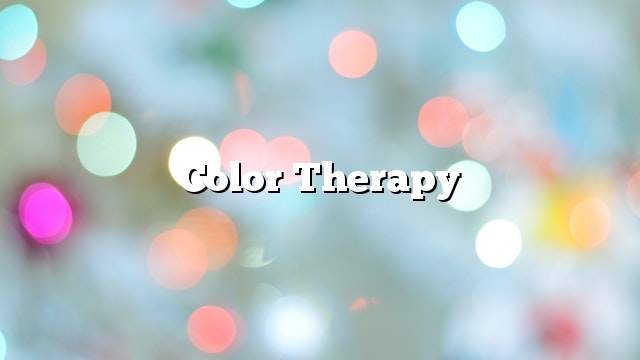Talking about colors is a cross-cutting theme. Some people see colors as coloring, painting, decorating, fashion, and there are many areas.
But have we ever asked ourselves whether colors affect our bodies? , Is it reasonable to treat ourselves in color? , Why do I like this color and do not like the other color ?? , And many many questions that wander in our mind …
Before starting anything, I would like to clarify the topics that we will address as follows:
1- Definition of colors.
2- Color therapy
First:
Definition of colors:
Color: It is the absorption of objects to the falling rays.
This is the simplest definition of color, so we do not see colors in dark places.
When talking about colors, remember the publication, this experiment is the only way to show the meaning of color.
When the rays fall off the prism, the rays break down and the body absorbs them, so each color appears according to the absorption of rays of the body. We see the seven colors of the spectrum:
Red, Blue, Yellow, Orange, Indigo, Green, Purple.
These colors are divided into two parts:
Basic: Red, Yellow, Blue
Secondary: The result of mixing colors as follows:
Red + Yellow = Orange
Red + Blue = Purple
Blue + Yellow = Green
Second :
The theory behind this treatment is that each color in the spectrum has a different oscillatory or vibrational frequency. Scientists believe that all cells in the body also have a frequency that is emitted strongly and positively when a person is healthy, but when he gets sick, this frequency becomes unbalanced, while the other theory says that different parts of the body, multiple disease situations and different emotional states respond better to different colors , And when the body is imbalanced it looks naturally for the colors it needs.
The main colors affecting the human are the color gradients of a rainbow of colors that include red, purple, orange, yellow, green, turquoise, blue, neon and purple. The first four are thought to be the most active colors while the last four are the quietest and most comfortable ones. It is useful in alleviating hormonal disorders, while orange activates the digestive system while green is useful for the heart and lungs, and blue is good for respiratory problems. Therapists use a wide variety of methods to treat their patients, covering them with colored scarves, shedding colored lights on different parts of their bodies, displaying certain colors on them, massaging them with colored oils or adding various colors to the wardrobe.
However, the scientific evidence supporting these theories is still weak, but some studies have shown some important results, including a study conducted in 1982 at the College of Nursing in San Diego in which 60 women in the mean age who suffered from rheumatoid arthritis for blue color for 15 minutes, Remarkable in the severity of the pain which has been significantly reduced than before.
Another study, conducted in 1990, showed red lights on the eyes of a group of migraine sufferers at the onset of Nubia. 93% of them recovered partially as a result of this treatment. Therapists attributed this to the fact that red color increases arterial blood pressure and enlarges blood vessels Bloody.
Experts pointed to the growing demand for parents to use colorful light boxes known as Laumatron to treat their children with problems ranging from autism to dyslexia, imbalance and incompatibility, after the treatment has achieved excellent results in this regard.
The therapeutic technique, developed by US neuroscientists, relies on narrow packets of colored light used to activate the light-receiving cells known as the elbows and cones behind the eye in several sessions of 20 minutes each to restore the balance of the autonomic nervous system. Therapists believe that this technique, if not treated, helps improve the mental health of the patient in general. For example, it can reduce mental and aggressive autism in children, help to provide psychological support and comfort to cancer patients and improve their quality of life.
One of the researchers says that the colors surrounding the human directly affect his psychology, and may cause the treatment of some diseases known as diseases of the UV, and psychologists were able to determine the relationship between the color of the person’s preference and characteristics and tendencies and joke and the spirit of control as well as his health, The light violet is used to live the patient in a state of separation from reality, and this color helps to resist the intense nervous emotions.
Researchers note that the red color reflects energy and vitality, and the people who prefer it are active, dynamic, dynamic, courageous and sensitive. They care more about the sensory aspect than about the moral side. Blue is cool and the people who love it are serious, sensitive characters.
The owners of the yellow color are happy and optimistic, while orange is a cheerful color and the owners of this color are social figures, while brown expresses the solid personality cohesive and iron will, while green is the color of tolerant characters, the color of the artists, creators and spirits, And is self-centered, while white is the color of rationality and tend his characters to rationality and intellectual balance.
